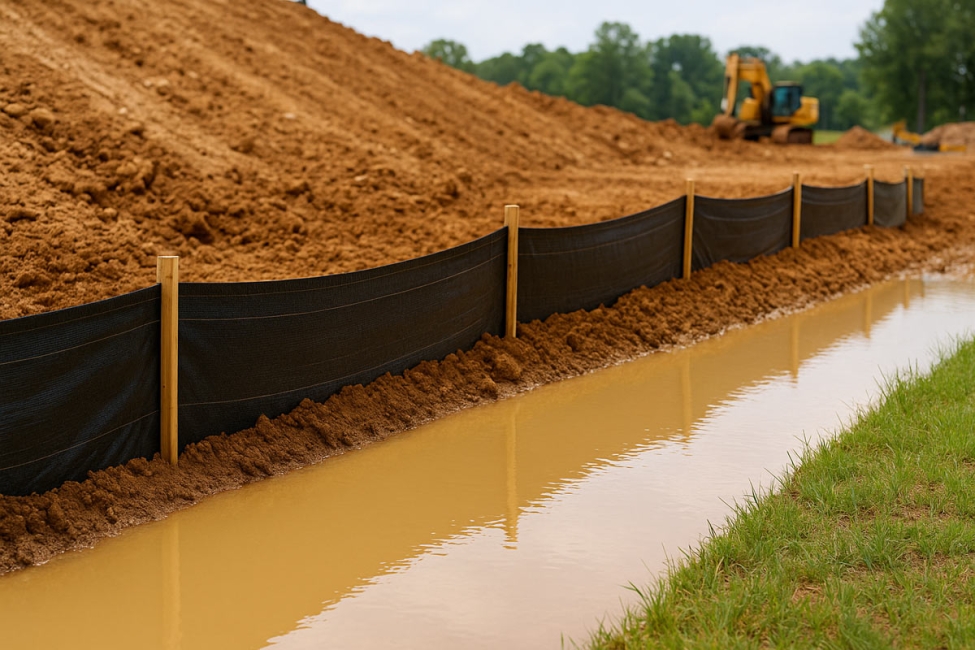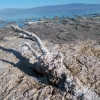
(In the photo above, the silt fence has been improperly installed, as you can see it was placed in loose, already excavated, soil.)
Why Construction Runoff Matters
A single acre of bare earth can release 10 - 20 times more sediment than the same acre in cropland, and up to 2,000 times more than a forested acre. That mud comes loaded with nutrients, concrete wash water, trash, and the occasional stray chemical, all of which lower dissolved-oxygen levels, smother habitat, and clog municipal pipes and ditches. (epa.gov)
Under the National Pollutant Discharge Elimination System (NPDES), every small “Phase II” MS4 must run a Construction Site Runoff Control program, which is one of six minimum control measures in its stormwater permit. At a minimum, the municipality must:
Adopt and enforce an erosion and sediment-control ordinance with sanctions.
Require builders to prepare and follow a Stormwater Pollution Prevention Plan (SWPPP).
Review site plans for water-quality impacts before ground is broken.
Inspect active sites and respond to public complaints.
Control on-site wastes such as concrete washout and litter. (epa.gov)
Failing to implement or enforce that program can trigger EPA or state orders to comply, federal assumption of enforcement, or even revocation of the MS4’s permit coverage. (epa.gov)
| Stage | Typical Best Management Practices (BMPs) | Key Tips |
|---|---|---|
| Planning & Design | Preserving existing vegetation, phasing soil disturbance, siting stockpiles away from drains | Keep the disturbed area as small as practical. |
| Perimeter Controls | Silt fence, compost socks, straw wattles, curb stone barriers, inlet protection | Install before earthwork begins, bury the bottom trench-depth. |
| Slope & Channel Protection | Rolled erosion-control blankets, turf reinforcement mats, check dams, temporary slope drains | Match products to soil type and flow velocity. |
| Sediment Containment | Sediment basins or traps, sediment bags, dredge spoils areas | Size basins for the 2-year, 24-hour storm unless your permit sets a different target. |
| Stabilization & Revegetation | Hydro-seeding, mulch with tackifier, sod, soil binders | Stabilize idle areas within 14 days (or the permit-specified deadline). |
| Pollution Prevention | Designated concrete washout, covered dumpsters, secondary fuel containment, spill kits | Train crews on housekeeping and keep records in the SWPPP log. |
| Good Housekeeping During Build-out | Stabilized construction entrance, street sweeping, daily inspection of BMPs, rainfall-triggered inspections | A clogged stone entrance is not an entrance—refresh rock as needed. |
| Consequence | Who Bears It? | Details & Examples |
|---|---|---|
| Administrative enforcement | Contractor and MS4 | Notices of Violation (NOVs), stop-work orders, mandatory BMP upgrades. |
| Civil penalties | Contractor, project owner, sometimes the MS4 | Clean Water Act § 309 allows fines of $2,500 – $25,000 per day for negligent violations and up to $50,000 per day for knowing violations. (epa.gov) |
| Criminal penalties | Individuals and corporations | Knowing endangerment can reach $250,000 and 15 years in prison for individuals, $1 million for organizations. (epa.gov) |
| State & local fines | Typically the contractor, sometimes the MS4 | New York City sets storm-water penalties from $2,000 to $10,000 per offense, plus corrective mandates. (codelibrary.amlegal.com) |
| Headline-grabbing settlements | Owner or prime contractor | Solar-farm builder Swinerton paid $2.3 million for uncontrolled sediment at multi-state sites. (apnews.com) |
| Loss of MS4 permit coverage | Municipality | EPA can “federally assume enforcement” if a town chronically fails to police sites. (epa.gov) |
| Environmental damage & cleanup costs | Public and private | Dredging silted streams and fixing eroded outfalls can dwarf the original project cost. |
Site Operator (Owner/Developer/General Contractor): Holds the Construction General Permit and is first in line for penalties.
Sub-contractors: Can be cited when their activities cause violations.
Municipality (MS4): Liable if it fails to enforce its own ordinance or ignores chronic problems.
Engineers/Consultants: Rarely fined, but can be named in civil actions if plans were clearly deficient.
Pre-construction meetings - Review the SWPPP with municipal staff and field superintendents.
Digital inspection apps - Time-stamped photos make enforcement and documentation easier.
Escalation ladder - Start with verbal warnings, then written NOVs, then stop-work orders.
Contract language - Tie payment milestones to BMP performance and final stabilization.
Continuous training Crew-level toolbox talks on erosion control keep the SWPPP from gathering dust.
Phase II MS4s must require, inspect, and enforce construction runoff controls for sites one acre and larger.
A layered approach—planning, perimeter controls, stabilization, and pollution prevention—keeps sediment on site.
Failure to comply can cost thousands per day, halt the project, or even bring criminal charges.
Municipalities share the risk; proactive ordinances, consistent inspections, and clear penalties protect waterways, and budgets.
 Wetlands are often described as the kidneys of the watershed because they filter, slow, and transform the water that passes through them in ways that …
Wetlands are often described as the kidneys of the watershed because they filter, slow, and transform the water that passes through them in ways that …
 Field inspections of catch basins, manholes, culverts, and outfalls form the foundation of responsible stormwater management. These routine checks giv…
Field inspections of catch basins, manholes, culverts, and outfalls form the foundation of responsible stormwater management. These routine checks giv…
 Habitat disruption around drainage structures is often subtle at first, and many of the earliest signs tend to appear during ordinary field work rathe…
Habitat disruption around drainage structures is often subtle at first, and many of the earliest signs tend to appear during ordinary field work rathe…
 Harmful algal blooms have become one of the most pressing water quality problems in many regions, and their rise has been linked to a complicated blen…
Harmful algal blooms have become one of the most pressing water quality problems in many regions, and their rise has been linked to a complicated blen…
 The Salton Sea is one of California’s most unusual and tragic landscapes, a place shaped by accident, transformed by ambition, and ultimately pu…
The Salton Sea is one of California’s most unusual and tragic landscapes, a place shaped by accident, transformed by ambition, and ultimately pu…
 *The screenshots used in this article are from Roadwurx, an asset management software created for road maintenance departments. Managing a town’…
*The screenshots used in this article are from Roadwurx, an asset management software created for road maintenance departments. Managing a town’…